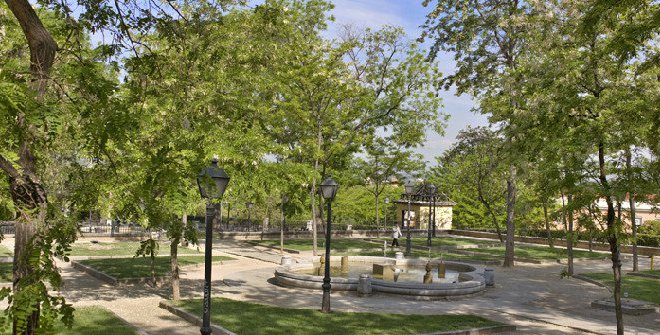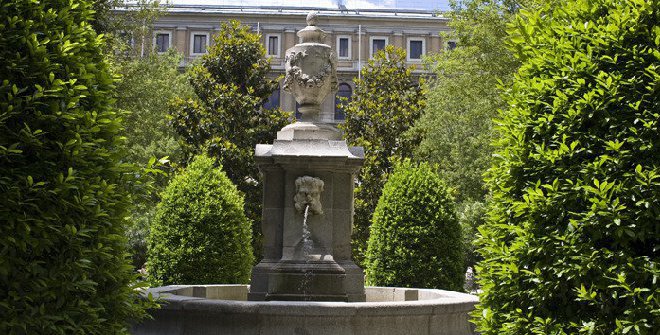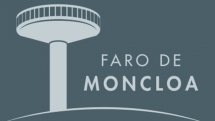Casa de Campo
The largest urban park in Spain, Casa de Campo is a short drive walk from central Madrid
 01_1407409970.685.jpg
01_1407409970.685.jpg lago_casa_4.jpg
lago_casa_4.jpg 02_1407410324.435.jpg
02_1407410324.435.jpg 03_1407410328.834.jpg
03_1407410328.834.jpg 04_1407410332.806.jpg
04_1407410332.806.jpg 05_1407410338.929.jpg
05_1407410338.929.jpg 06_1407410342.666.jpg
06_1407410342.666.jpg 07_1407410346.801.jpg
07_1407410346.801.jpg

- Park information and history
- Kids
- Sports
- Entertainment and leisure
At over 1,722 hectares, Casa de Campo is the largest urban park in Spain. Situated to the southwest of Madrid, it’s flanked by the banks of the River Manzanares, the municipality of Pozuelo and other wooded areas such as Monte del Pardo. The most common trees are holm oaks and pines, in the style of most meadows in the Castilian plateau.
The importance of Casa de Campo rose when King Philip II of Spain moved the court to Madrid in 1561 and the royal residence was established in the old fortress, which stood on the site of the present-day Royal Palace. A keen hunter, the King wanted to have his court located close to a hunting ground. To honour his wish, he acquired the manor from the Vargas family and the adjoining lands as well. Two centuries later, King Ferdinand VI of Spain named Casa de Campo a Royal Forest. In 1931, under the Second Republic, the property passed from the Crown to Madrid City Council.
Evidence of the noble and royal past are the Palace of Vargas, the Puente de la Culebra bridge, the Tapia (wall) and the gardens of El Reservado.
Encompassing leisure facilities, Casa de Campo is a great park for kids.
The Parque de Atracciones (amusement park) features more than 30 rides and attractions for both adrenaline junkies and the fainthearted. La Lanzadera is a freefall ride where riders drop 63 metres at 80km/h. Before returning to the ground, if you’re not too scared up there, you can enjoy beautiful views of the city. El Abismo is a cutting-edge roller coaster with many spirals and hills, with a 49m drop and a top speed of 100km/h. The park has water attractions and a haunted house as well, plus shows, play zones and places to sit down and relax.
The Zoo Aquarium in Madrid has more than 2,000 animals from more than 500 species. These include curious specimens such as an albino Bengal tiger, as well as species in serious danger of extinction such as the koala and the Barbary lion. In April 2024, a new pair of pandas came to live at the Madrid Zoo, the male Jin Xi and the female Zhu Yu, both born in 2020, where they will live for 10 years under the Collaboration Agreement for Conservation, Research and Breeding of the Giant Panda signed with China.
You can also enjoy displays with dolphins, birds of prey, exotic birds and sea lions along with the aquarium that houses various kinds of sharks.
Casa de Campo attracts all kinds of sports lovers. Its 16km-long circuit made of asphalt roads and dirt trails is used extensively for jogging and running. (Nota para los maquetadores: hay que poner un enlace al contenido “Dónde Ir//Deporte//Corre en Madrid”.)
Cycling enthusiasts can be seen riding road or mountain bikes in Casa de Campo. For road cyclists there are paved roads to roll safely within the park, away from heavy traffic, while mountain bikers have numerous trails and narrow drives.
As for water sports, the Lake, after extensive restoration work in 2018, is a perfect place to enjoy nature whilst having something to eat or drink in the bars and restaurants around it, as well as practicing water sports. Sailing in small vessels is permitted so it is possible to go canoeing and rowing. Furthermore, it is possible to go swimming at the Lago Municipal Sports Centre, which has an indoor pool and three outdoor pools, which are open during the summer.
Casa de Campo has been the venue for various international sports competitions. It has held heats of the Triathlon World Cup and the Mountain Bike World Cup, and even an edition of the Cycling World Championships, with a circuit that went around the entire facilities.
During your sightseeing day in Madrid, you can go to Casa de Campo for a break, since the park is a short distance from the Royal Palace, La Almudena Cathedral or the Chapel of San Antonio de la Florida. A leisurely stroll across this open green space will give you fresh air and tranquillity within city limits.
The Lake at Casa de Campo is a perfect place to enjoy nature, the sun and the views whilst having something to eat or drink in the bars and restaurants around it, as well as doing some water sports. The surrounding area has several restaurants with an interesting gastronomic offer that will make you appreciate this natural beauty spot in Madrid even more. One option is Villa Verbena, a terrace that serves up flame-grilled dishes and a culinary offer based on good quality products and simple recipes. You can also visit La Taberna de Triciclo offering authentic local cuisine, chargrilled dishes and views of the lake; El Urogallo which offers an innovative culinary experience; and Café del Lago, which combines a high quality dining experience with nature and an extensive cocktail menu.
The Casa de Campo Trade Fair Park hosts conferences, conventions, fairs, sporting events, business meetings, concerts and theatre plays around the year in its four multi-purpose halls, the theatre/auditorium and the outdoor stage. The Pabellón de los Hexágonos is particularly worth a visit, an emblematic building from the twentieth century designed by architects José Antonio Corrales and Ramón Vázquez Molezún.
You can also visit the Madrid In Game. Video game campus that brings together large companies and training centres in the sector.
The Glass Pavilion at Casa de Campo also boasts an extensive exhibition area, divided into three levels or floors with capacity for a large number of people, so it is a unique venue to hold major themed shows and exhibitions. Among them, we can highlight ClassicAuto Madrid, Beermad, an event where you can sample different varieties of beer and enjoy concerts, workshops, and tastings; or Stock, Feria Outlet Madrid with discounts on leading brands of fashion, sporting goods, children's wear, surf and snow gear, urban wear, accessories, motorcycle gear, home goods, beds and mattresses, and much more.
Furthermore, Casa de Campo Trade Fair Park hosts the Agricultural Chamber’s Market Day. The purpose of this event is none other than raising public awareness of our community’s agricultural products through the producers themselves, rather than through intermediaries.
-
Map of Tourist Areas (PDF)
-
Oeste Park
-
Plaza de Oriente Gardens
-
Vistillas Gardens
-
Tropical Garden at Madrid - Puerta de Atocha - Almudena Grandes station
-
CaixaForum Vertical Garden
-
Palacio del Príncipe de Anglona Gardens
-
Reina Sofia Museum Gardens
-
Huerto de las Monjas
-
Sporting events in Madrid




















